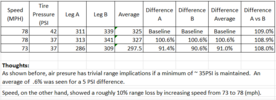Objective:
I wondered just how significant air pressure really is to EV range and decided to test it.
Background:
Car, (MYLR) left a 60f heated garage to 40f ambient and was driven 25 miles to warm up. Air pressures were validated between 2 digital gauges (which match to within ¼ psi, and tire TPMS. 11 mile interstate runs with speed matched, trip odo reset @ identical start and stop points, autopilot and self-driving managing the car, and all climate/HVAC off. Runs are back to back, at night, same direction, with traffic a non-factor. Tire pressures were checked via TPMS before and after each run. The 35 psi run did show a ½ PSI increase from start to, so there was some heat increase.
I used large gaps in speed and pressure so we’d get obvious results.
As the 50mph (lower wind resistance) was repeatable it suggested the process didn’t require two passes @ 35 psi. (I was also low on battery. Got home at 2%.)
Results:

Thoughts:
Note: This will be added to the "Air Pressure" document I've shared/linked to elsewhere.
I wondered just how significant air pressure really is to EV range and decided to test it.
Background:
Car, (MYLR) left a 60f heated garage to 40f ambient and was driven 25 miles to warm up. Air pressures were validated between 2 digital gauges (which match to within ¼ psi, and tire TPMS. 11 mile interstate runs with speed matched, trip odo reset @ identical start and stop points, autopilot and self-driving managing the car, and all climate/HVAC off. Runs are back to back, at night, same direction, with traffic a non-factor. Tire pressures were checked via TPMS before and after each run. The 35 psi run did show a ½ PSI increase from start to, so there was some heat increase.
I used large gaps in speed and pressure so we’d get obvious results.
As the 50mph (lower wind resistance) was repeatable it suggested the process didn’t require two passes @ 35 psi. (I was also low on battery. Got home at 2%.)
Results:
Thoughts:
- The 45 psi runs showed no tire pressure changes. 35 psi run did show a ½ PSI increase from start to finish so there was some heat increase.
- I don’t get these lowish power demand number in real life. Climate control has a big impact!
- I expected tire rolling resistance to play a reduced role at higher speeds, but I wasn’t so sure we’d see it, nor that it would be this significant.
- I’m a little bummed the two 75mph runs don’t match more, but at higher speeds it doesn’t take much for even minor wind changes to affect things.
- Ride difference was significant and immediately noticeable.
- I was surprised at the how significant air pressure changes are at lower speeds
- Although that usually means I’m local and care not at all.
- On a real-life trip where I’m expecting something like 250 miles of range at most? I’m not likely to worry about what is likely to be less than 5 miles of range difference.
- Range/pressure is not linear. Delta drops as pressure increases. Meaning the increase in 35-40 is larger than the increase from 40-45.
- I don’t run 35 PSI either. I normally inflate to 37-38 and add when I hit the 35 PSI warning light.
Note: This will be added to the "Air Pressure" document I've shared/linked to elsewhere.



